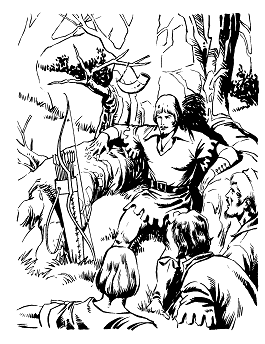
Robin Hood is a legendary heroic outlaw originally depicted in English folklore and subsequently featured in literature, theatre, and cinema. According to legend, he was a highly skilled archer and swordsman. In some versions of the legend, he is depicted as being of noble birth, and in modern retellings he is sometimes depicted as having fought in the Crusades before returning to England to find his lands taken by the Sheriff. In the oldest known versions, he is instead a member of the yeoman class. Traditionally depicted dressed in Lincoln green, he is said to have stolen from the rich to give to the poor.

Robin Hood's Bay is a village in North Yorkshire, England. It is 6 miles (10 km) south of Whitby and 15 miles (24 km) north of Scarborough on the Yorkshire Coast.
Robin Hood's Chase is Child ballad 146 and a sequel to Child ballad 145, "Robin Hood and Queen Katherine". This song has survived as, among other forms, a late seventeenth-century English broadside ballad. It is one of several ballads about the medieval folk hero that form part of the Child Ballads, a comprehensive collection of traditional English and Scottish ballads.
"Robin Hood's Progress to Nottingham" is Child ballad 139, an original story that is part of the Robin Hood canon. This song has survived as, among other forms, a late 17th-century English broadside ballad, and is one of several ballads about the medieval folk hero that form part of the Child ballad collection, which is one of the most comprehensive collections of traditional English ballads.

Robin Hood's Death, also known as Robin Hoode his Death, is an Early Modern English ballad of Robin Hood. It dates from at the latest the 17th century, and possibly originating earlier, making it one of the oldest existing tales of Robin Hood. It is a longer version of the last six stanzas of A Gest of Robyn Hode, suggesting that one of the authors was familiar with the other work and made an expansion or summary of the other, or else both were drawing from a lost common tale. The surviving version in the Percy Folio is fragmentary, with sections missing. A more complete but later version is from the middle of the 18th century, and is written in modern English. Both versions were later published by Francis James Child as Child ballad #120 in his influential collection of popular ballads.
Robin Hood and the Tanner is Child ballad 126. It is a late seventeenth-century English broadside ballad and one of several ballads about the medieval folk hero Robin Hood that form part of the Child ballad collection, which is one of the most comprehensive collections of traditional English ballads but has now been subsumed and surpassed by the Roud Folk Song Index.

Robin Hood and the Potter is a 15th century ballad of Robin Hood. While usually classed with other Robin Hood ballads, it does not appear to have originally been intended to be sung, but rather recited by a minstrel, and thus is closer to a poem. It is one of the very oldest pieces of the surviving Robin Hood legend, with perhaps only Robin Hood and the Monk older than it. It inspired a short play intended for use in May Day games, attested to around 1560. It was later published by Francis James Child as Child ballad #121 in his influential collection of popular ballads in the 1880s.
Robin Hood and the Butcher is a story in the Robin Hood canon which has survived as, among other forms, a late seventeenth-century English broadside ballad, and is one of several ballads about the medieval folk hero that form part of the Child ballad collection, which is one of the most comprehensive collections of traditional English ballads. It may have been derived from the similar Robin Hood and the Potter.
Robin Hood's Golden Prize is Child ballad 147. It is a story in the Robin Hood canon which has survived as, among other forms, a late seventeenth-century English broadside ballad, and is one of several ballads about the medieval folk hero that form part of the Child ballad collection, which is one of the most comprehensive collections of traditional English ballads.
Robin Hood's Delight is Child ballad 136. It is a story in the Robin Hood canon which has survived as, among other forms, a late seventeenth-century English broadside ballad, and is one of several ballads about the medieval folk hero that form part of the Child ballad collection, which is one of the most comprehensive collections of traditional English ballads.

A Gest of Robyn Hode is one of the earliest surviving texts of the Robin Hood tales. Written in late Middle English poetic verse, it is an early example of an English language ballad, in which the verses are grouped in quatrains with an ABCB rhyme scheme, also known as ballad stanzas. Gest, which means tale or adventure, is a compilation of various Robin Hood tales, arranged as a sequence of adventures involving the yeoman outlaws Robin Hood and Little John, the poor knight Sir Richard at the Lee, the greedy abbot of St Mary's Abbey, the villainous Sheriff of Nottingham, and King Edward of England. The work survives in printed editions from the early 16th century, just some 30 years after the first printing press was brought to England. Its popularity is proven by the fact that portions of more than ten 16th- and 17th-century printed editions have been preserved. While the oldest surviving copies are from the early 16th century, many scholars believe that based on the style of writing, the work likely dates to the 15th century, perhaps even as early as 1400. The story itself is set somewhere from 1272 to 1483, during the reign of a King Edward; this contrasts with later works, which generally placed Robin Hood earlier in 1189–1216, during the reigns of Richard I of England and John, King of England.
Robin Hood and the Bishop is number 143 in Francis James Child's collection of Child ballads, and describes an adventure of Robin Hood. This song has also survived as a late seventeenth-century English broadside ballad, and is one of several ballads about the medieval folk hero that form part of the Child ballad collection, which is one of the most comprehensive collections of traditional English ballads.
A True Tale of Robin Hood is Child ballad 154, featuring Robin Hood and, indeed, presents a full account of his life, from before his becoming an outlaw, to his death. It describes him as the Earl of Huntington, which is a fairly late development in the ballads. It definitively places him in Richard the Lionhearted's reign.

Robin Hood and the Monk is a Middle English ballad and one of the oldest surviving ballads of Robin Hood. The earliest surviving document with the work is from around 1450, and it may have been composed even earlier in the 15th century. It is also one of the longest ballads at around 2,700 words. It is considered one of the best of the original ballads of Robin Hood.
Robyn and Gandeleyn is an English ballad. The poem is in Sloane Manuscript 2593, a document of lyrics and carols which dates from around 1450. It was first printed by Joseph Ritson in his 1790 collection Ancient Songs. It was later republished in the second half of the 19th century in an anthology of traditional English and Scottish ballads by Francis James Child known as the Child Ballads, where it is Child Ballad 115. Child also divided the continuous text into seventeen stanzas.
Robin Hood and the Shepherd is a story in the Robin Hood canon which has survived as, among other forms, a late seventeenth-century English broadside ballad, and is one (#135) out of several ballads about the medieval folk hero that form part of the Child ballad collection, which is one of the most comprehensive collections of traditional English ballads.
"Robin Hood and the Beggar" is a story in the Robin Hood canon which has survived as, among other forms, a late seventeenth-century English broadside ballad, and is a pair out of several ballads about the medieval folk hero that form part of the Child ballad collection, which is one of the most comprehensive collections of traditional English ballads. These two ballads share the same basic plot device in which the English folk hero Robin Hood meets a beggar.

The Merry Men are the group of outlaws who follow Robin Hood in English literature and folklore. The group appears in the earliest ballads about Robin Hood and remains popular in modern adaptations. History The Merry Men are Robin Hood's group who work to rob from the rich and give to the poor. They have antagonized the tyrannical rule of Prince John while King Richard is fighting in the Crusades. This also puts them into conflict with Prince John's minions, Guy of Gisbourne and the Sheriff of Nottingham.

Robin Hood and Little John is Child ballad 125. It is a story in the Robin Hood canon which has survived as, among other forms, a late seventeenth-century English broadside ballad, and is one of several ballads about the medieval folk hero that form part of the Child ballad collection, which is one of the most comprehensive collections of traditional English ballads.
The Forresters Manuscript is a quarto book of 21 English Robin Hood ballads, believed to have been written sometime in the 1670s. It's named the Forresters Manuscript after the first and last ballads in the book, which are both titled in the book, Robin Hood and the Forresters.This manuscript remained undiscovered and unknown for over 300 years after it was written until it turned up at an auction house in 1993, where it was found by the Bristol bookseller A. R. Heath, sold to the London book-dealer Bernard Quaritch Ltd., and then came to rest in the British Library. It was then published for the first time in 1998 as Robin Hood: The Forresters Manuscript, edited by Stephen Knight.









